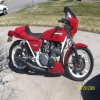Elevation ? too lean or to rich?
- Z1r Crazy
-
Topic Author
- Offline
- User
-

Registered
- Posts: 27
- Thanks: 0
Elevation ? too lean or to rich?
11 Mar 2006 09:53
Ok I bought my bike from CA, witch the city is 60 ft above sea level..Im in iowa witch is 925ft. So will this make it leaner or richer? I think it will be leaner. but wanted to check. Thanks
Please Log in or Create an account to join the conversation.
- hwms
-
- Offline
- User
-

Registered
- Posts: 263
- Thanks: 1
Re: Elevation ? too lean or to rich?
11 Mar 2006 11:49
Delete
Post edited by: hwms, at: 2006/03/12 14:04
Post edited by: hwms, at: 2006/03/12 14:04
Please Log in or Create an account to join the conversation.
- KZQ
-
- Offline
- Administrator
-

Registered
- Walking Behind the Corn May Not Be All That!
- Posts: 4851
- Thanks: 1653
Re: Elevation ? too lean or to rich?
11 Mar 2006 12:32
Higher elevations generally mean a bike will run richer. I know it sounds counterintuitive, but think of it like this the fuel delivered does not vary as much as the air does. At higher elevations there is less air and the mixture ends up being richer. At lower elevations the air is denser and because more air is available the mixture is leaner.
Don't ask me why the less dense air at higher elevations doesn't just draw less fuel. If it worked like this the system would stay in balance. Could it be that there is less oxygen at higher elevations? If so that would make better sense to me.
In any case the difference between 60 feet and 925 feet is insignificant, you'll never notice it while just road riding.
KZCSI
Post edited by: KZCSI, at: 2006/03/11 15:36
Don't ask me why the less dense air at higher elevations doesn't just draw less fuel. If it worked like this the system would stay in balance. Could it be that there is less oxygen at higher elevations? If so that would make better sense to me.
In any case the difference between 60 feet and 925 feet is insignificant, you'll never notice it while just road riding.
KZCSI
Post edited by: KZCSI, at: 2006/03/11 15:36
www.KZ1300.com
Riders:
1968 BSA 441 Shooting Star, 1970 BSA 650 Lightning, 1974 W3, 1976 KZ900, 1979 KZ750 Twin, 1979 KZ750 Twin Trike, 1981 KZ1300, 1982 KZ1100 Spectre, 2000 Valkyrie, 2009 Yamaha Roadliner S. 1983 GL 1100
Projects:
1985 ZN1300
Riders:
1968 BSA 441 Shooting Star, 1970 BSA 650 Lightning, 1974 W3, 1976 KZ900, 1979 KZ750 Twin, 1979 KZ750 Twin Trike, 1981 KZ1300, 1982 KZ1100 Spectre, 2000 Valkyrie, 2009 Yamaha Roadliner S. 1983 GL 1100
Projects:
1985 ZN1300
Please Log in or Create an account to join the conversation.
- hwms
-
- Offline
- User
-

Registered
- Posts: 263
- Thanks: 1
Re: Elevation ? too lean or to rich?
11 Mar 2006 18:15
Delete
Post edited by: hwms, at: 2006/03/12 14:04
Post edited by: hwms, at: 2006/03/12 14:04
Please Log in or Create an account to join the conversation.
- baldy110
-

- Offline
- User
-

Registered
- Posts: 2272
- Thanks: 512
Re: Elevation ? too lean or to rich?
11 Mar 2006 18:47
At 925 ft you wont even feel the difference. Rule of thumb is the higher you go the less fuel you are going to need. So as elevation gets higher your carburation will get richer.
Post edited by: baldy110, at: 2006/03/11 21:54
Post edited by: baldy110, at: 2006/03/11 21:55
Post edited by: baldy110, at: 2006/03/11 21:54
Post edited by: baldy110, at: 2006/03/11 21:55
Please Log in or Create an account to join the conversation.
- steell
-

- Offline
- User
-

Registered
- Posts: 6849
- Thanks: 208
Re: Elevation ? too lean or to rich?
11 Mar 2006 18:53
As altitude increases, atmospheric pressure decreases, air, being a gas, expands due to the lesser pressure, while the composition of the air remains the same.
Air weighs .0755 pounds per cubic foot at sea level, as explained above it will weigh less at higher altitudes. Air contains approx 21% oxygen, and oxygen is what the fuel combines with to cause combustion. So at sea level the motor will be getting approximately .02 lbs of oxygen per cubic foot, and at 10,000 feet altitude it will be getting approximately .014 lbs of oxgen per cubic foot of air. Since the fuel flow stays constant, and there is less oxygen, not all the fuel burns, ie the motor is running rich
A turbocharger solves the problem nicely :laugh:
Air weighs .0755 pounds per cubic foot at sea level, as explained above it will weigh less at higher altitudes. Air contains approx 21% oxygen, and oxygen is what the fuel combines with to cause combustion. So at sea level the motor will be getting approximately .02 lbs of oxygen per cubic foot, and at 10,000 feet altitude it will be getting approximately .014 lbs of oxgen per cubic foot of air. Since the fuel flow stays constant, and there is less oxygen, not all the fuel burns, ie the motor is running rich

A turbocharger solves the problem nicely :laugh:
KD9JUR
Please Log in or Create an account to join the conversation.
Moderators: Street Fighter LTD
